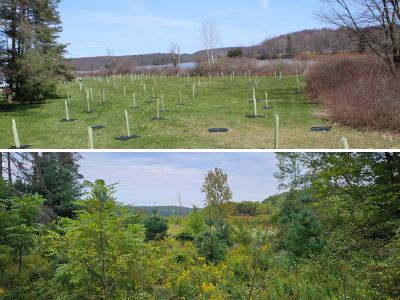Indiana, Pa. – February 26, 2025 – Landowners in more than 30 counties across western and central Pennsylvania with open or mostly open land along waterways can apply to the Western Pennsylvania Conservancy to have native trees planted at no cost as part of the statewide water quality improvement goals.
Riparian trees can improve water quality and wildlife habitat by stabilizing streambanks, reducing sedimentation, cooling water temperatures and filtering pollutants such as excess nitrogen and phosphorus. Some native tree species that will be available include oaks, maples, hickory, sycamore, dogwoods and willows.
reducing sedimentation, cooling water temperatures and filtering pollutants such as excess nitrogen and phosphorus. Some native tree species that will be available include oaks, maples, hickory, sycamore, dogwoods and willows.
With the help of partners and volunteers, since 2013, WPC’s watershed conservation team has planted more than 100,000 riparian trees along waterways throughout the region.
In general, to be considered, sites should have:
- a stream, including intermittent tributaries, springs and runs, that has little to no woody vegetation within 35 feet of the streambank;
- at least 250 feet of linear bank and a 50-foot setback from the stream edge (approximately ¼ of an acre of open riparian area);
- a public or private landowner, including farmers, willing to allow native trees to be planted within a mapped project area and consent to a multiyear landowner agreement.
Typical projects will not extend beyond 150 feet from the stream edge but may have a limitless length adjacent to the stream. (Some sites might vary from these parameters; circumstances will be reviewed on a project-by-project basis.)
Landowners with land along waterways in more than 30 counties may apply. Those counties include, but are not limited to:
Allegheny, Armstrong, Beaver, Bedford, Blair, Butler, Cambria, Cameron, Clarion, Clearfield, Crawford, Elk, Erie, Fayette, Forest, Fulton, Greene, Huntingdon, Indiana, Jefferson, Lawrence, McKean, Mercer, Potter, Somerset, Tioga, Venango, Warren, Washington and Westmoreland.
Landowners statewide may apply because other funding sources are available for those in locations outside the named 30 counties.
The Conservancy plans to begin site visits by June 2025. Planting by WPC watershed staff (or contractor selected by WPC) will begin in the fall of 2025 and continue during the 2026 and 2027 spring and fall planting seasons. Project implementation will be on a first-come, first-planted basis.
To deem suitability, landowners should complete a Riparian Restoration Tree Planting Initiative application on the WPC website or email Monica Lee with contact information, listing “Riparian Trees” in the subject line.
Applications will be accepted and reviewed year-round through June 2027.
###
About the Western Pennsylvania Conservancy:
The Western Pennsylvania Conservancy (WPC) enhances the region by protecting and restoring exceptional places. A private nonprofit conservation organization founded in 1932, WPC has helped establish 11 state parks, conserved more than 290,000 acres of natural lands, protected or restored more than 3,000 miles of rivers and streams, and assessed thousands of wildlife species and their habitats. The Conservancy owns and operates Frank Lloyd Wright’s Fallingwater, which is on the UNESCO World Heritage List and symbolizes people living in harmony with nature. In addition, WPC enriches our region’s cities and towns through 130 community gardens and other green spaces and thousands of trees that are planted with the help of more than 7,000 volunteers. The work of the Conservancy is accomplished through the support of more than 10,000 members. For more information, visit WaterLandLife.org or Fallingwater.org.
Media Contact:
Jennifer Sumoske
Communications Specialist
412-586-2328, work
jsumoske@paconserve.org
